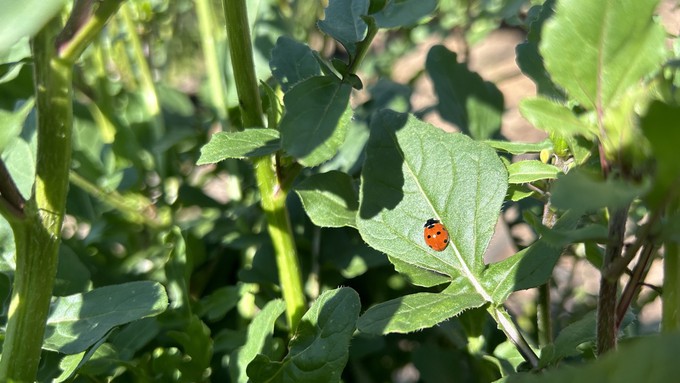
Super weather for late-winter gardening on tap

A lady beetle rests in the sun on a large arugula plant. We should have sunny or at least dry weather for gardening through Wednesday. Kathy Morrison
For Super Bowl week, Sacramento gets a break in between storms with sunny skies – and cold nights. It may look like spring during the day, but overnight temperatures will dip into the high 30s, says the National Weather Service. That will keep ground temperatures cold, too, as well as bring the possibility of patchy ground fog in the mornings.
Afternoon highs will hover around 60 degrees – normal for mid-February in Sacramento. If you have outdoor plans on Valentine’s Day (Wednesday), it should be dry and 62 degrees.
Clouds and possible precipitation are back in the forecast on Thursday night and Friday. According to the weather service, Sacramento has a 50% chance of rain on Friday night.
Before that next round of storms, take advantage of the sunny (but brisk) days this week and show your garden some TLC.
* This is the last chance to spray fruit trees before they bloom. Treat peach and nectarine trees with copper-based fungicide. Spray apricot trees at bud swell to prevent brown rot. Apply horticultural oil to control scale, mites and aphids on fruit trees soon after a rain (like right now). But remember: Oils need at least 24 hours to dry to be effective.
* Clean up tree debris knocked down by last week’s wind and rain.
* Feed spring-blooming shrubs and fall-planted perennials with slow-release fertilizer. Feed mature trees and shrubs after spring growth starts.
* Remove aphids from blooming bulbs with a strong spray of water or insecticidal soap.
* Fertilize strawberries and asparagus.
* Transplant or direct-seed spring and summer flowers, including snapdragon, candytuft, lilies, astilbe, larkspur, Shasta and painted daisies, stocks, bleeding heart and coral bells.
* In the vegetable garden, plant Jerusalem artichoke tubers, and strawberry and rhubarb roots.
* Transplant cabbage and its close cousins – broccoli, kale and Brussels sprouts – as well as lettuce (both loose leaf and head).
* Indoors, start peppers, tomatoes and eggplant from seed.
* Plant artichokes, asparagus and horseradish from root divisions. Plant potatoes from tubers and onions from sets (small bulbs). The onions will sprout quickly and can be used as green onions in March.
* From seed, plant beets, chard, lettuce, mustard, peas, radishes and turnips.
* Plant flowering perennials such as columbine and delphinium.
* Plant summer-flowering bulbs including cannas, calla lilies and gladiolus.
Comments
0 comments have been posted.Sacramento Digs Gardening to your inbox.
Sites We Like
Garden Checklist for week of July 21
Your garden needs you!
* Keep your vegetable garden watered, mulched and weeded. Water before 8 a.m. to reduce the chance of fungal infection and to conserve moisture.
* Feed vegetable plants bone meal, rock phosphate or other fertilizers high in phosphate to stimulate more blooms and fruiting. (But wait until daily high temperatures drop out of the 100s.)
* Don’t let tomatoes wilt or dry out completely. Give tomatoes a deep watering two to three times a week.
* Harvest vegetables promptly to encourage plants to produce more. Squash especially tends to grow rapidly in hot weather. Keep an eye on zucchini.
* Pinch back chrysanthemums for bushy plants and more flowers in September.
* Remove spent flowers from roses, daylilies and other bloomers as they finish flowering.
* Pinch off blooms from basil so the plant will grow more leaves.
* Cut back lavender after flowering to promote a second bloom.
* It's not too late to add a splash of color. Plant petunias, snapdragons, zinnias and marigolds.
* From seed, plant corn, pumpkins, radishes, winter squash and sunflowers.